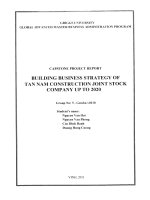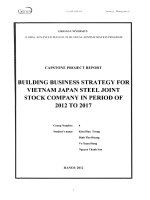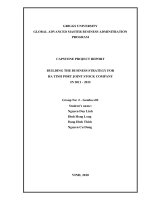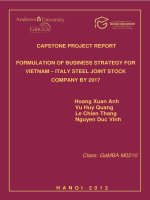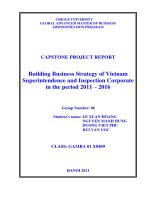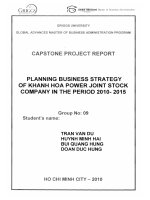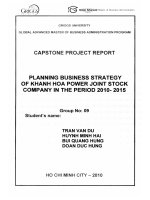DEVELOPING a GENERAL BUSINESS STRATEGY OF VIETNAM INTERNATIONAL COMMERCIAL JOINT STOCK BANK (VIB) PERIOD 2015 2020
Bạn đang xem bản rút gọn của tài liệu. Xem và tải ngay bản đầy đủ của tài liệu tại đây (2.77 MB, 94 trang )
DEVELOPING A GENERAL BUSINESS STRATEGY OF VIETNAM
INTERNATIONAL COMMERCIAL JOINT STOCK BANK (VIB) PERIOD
2015-2020
FOREWORD
1. Reason for choosing topic:
The event of Vietnam joining the World Trade Organization (WTO) marked a great
turning-point for Vietnam’s economy. Opportunities are waiting for the enterprises
who know how to invest, search and utilize. However, existing alongside with
opportunities are always threats, dangers, challenges, and risks that can arise at
anytime and they will make businesses face with difficulties if there is no full
preparation for courses to deal with them.
With competitions happening more and more severe and violent in the market, each
business should prepare readily with effective courses in order to exist and develop
solidly. A corporation with sound and suitable business strategies, being able to lean
on internal forces to make use of opportunities coming from external environment
or to avoid risks, restrict weaknesses will certainly be strong enough to compete and
stand firmly in the market.
2009 is the 3rd year that Vietnam’s economy joined WTO more and more wholly,
among that the most important thing is that the presence of banks with 100 percent
foreign fund. Opportunites and threats are waiting for banks, including Vietnamese
International Commercial Joint Stock Bank (VIB). While domestic banks are
expanding their networks, the establishment of domestic banks and the existence of
banks with 100 percent foreign fund will lead to more severe competitions.
For VIB, in the conditions where the economy always changes with many chances
but also several challenges, the competition in banking industry is increasingly
severe with the participation of foreign banks, and direct competitors is domestic
commercial joint stock banks, to create a firm and stable position will require a lot
of efforts to maintain the market share and develop more. Nonetheless, VIB has
distinguished itself as a star in the joint stock bank system by applying modern
1
organizational and management models, strategies of establishing brand image with
the guideline “Managing according European style, trading according to Eastern
philosophy” (According to a Board of Directors Chairman in power). Depending on
available advantages of the brand name of VIB and internal forces which is the
determination and singleness of mind of the Board of Directors, Board of
Management, and staffs, VIB was successful in building and carrying out the
business strategy period 2003-2007.
So as to maintain its position and continue pursuing the objective of leading VIB to
become one of the top five joint stock banks of Vietnam and to harmonize with the
new era – era of globalization, VIB needs to develop strategies to make it expand
faster, firmly, safely and effectively together with restructuring the system
corresponding to customer-oriented product lines.
With these reasons, our group has decided to choose the topic “Developing a
general business strategy of Vietnam International Commercial Joint Stock Bank
(VIB) period 2015 - 2020” to do research.
2. Goal and meaning:
-
Goal: Using researched theories combined with analyzing practices to bring up
effective business strategies for VIB from now to 2013.
-
Meaning: According to scientific foundation, this research project came into
being with the desire of contributing some strength for the chosen institution –
Vietnam International Commercial Joint Stock Bank (VIB).
3. Object and area of research:
-
Research object: Business strategies of businesses.
-
Research area: Banking environment, competitors’ strategies, and business
strategies of VIB.
4. Research method:
2
By several methods like quantitative and qualitative methods, combined with
analysis, statistics, and expert method, the coursework was carried out for research
at VIB bank to gain the most comprehensive and exact results. Based on that basic,
our group are then able to bring out effective strategies.
5. Topic’s struture: consisting of foreword and conclusion, the essay’s structure
consists of three parts:
Chapter I: General theories of business strategy
Chapter II: Analysing the actual state of VIB
Chapter III: Develop a general business strategies for VIB period 2015 - 2020,
realization solutions and conclusion.
3
CHAPTER I
GENERAL THEORIES OF BUSINESS STRATEGY
1.1 – Notions and role of business strategy in corporations:
1.1.1. Some notions about business strategy:
The terminology “strategy” started from military field. In military, strategy is
defined as: the art of combining military forces, mental and economic politics
mobilized to win over the enemy. Though, nowadays, the term “strategy” are used
frequently in business field. Although it started long ago, there has not been an
absolutely exact and sufficient definition for this term. Some notions about business
strategy are as follow.
According to Michearl Porter, a professor of Havard University: “Business strategy
is the art of creating competetive edges”. Like that, business strategy is one of
means to compete among corporations; it is a way for corporations to attain the
proposed objects by creating competitive edges, or equivalently, by creating
strengths, opportunities, dangers, challenges, etc, thus point out suitable solutions to
succeed in business.
As the consultation group of Boston Consulting Group (BCG) stated: “Business
stratedy is the division of corporations’ available resources and take the competitive
position.” This means that corporations, by analyzing its resources and business
divisions then dividing its resources in the most effective way, point out objectives
and tactics to realize those objectives with the greatest effect to generate dominance
to compete.
According to Alain Charles Martinet: “Strategy is the art corporations use to
prevent competition and gain success.” Hence, strategy is to sketch out firm and
lasting evolvement orbits, around those orbits may be able to organize right
decisions and actions of corporations.
4
In business environment, the term “strategy” mostly arises from basic laws. Yet,
applying this term always fails due to lack of knowledge about its nature and use.
Therefore, it is difficult to get a united definition about “strategy” because of two
reasons: (1) strategy consists different aspects, and (2) strategy has individuality, it
changes with circumstances of each business, in each typical branch. However,
there are at least three types of strategy in business world, which are: strategy or
normal strategy, corporate strategy, and competitive strategy.
Figure 1.1: Strategy
Therefore, there are many definitions about strategy, but focused on four main
areas: plan, model, position and prospect. In accordance with these points of view,
strategy is:
(1) A plan showing what to do from one thing to get another thing.
(2) A lasting activity model, for example a company which always promotes costly
products, it is using the strategy “focusing on objects with high income”.
(3) Position, which indicates decisions of bringing special goods or services to
special markets.
(4) Future prospect, which is line of vision and orientation which helps corporations
or organizations expand.
5
1.1.2. Role of business strategy.
A defined business strategy is equivalent to corporations answering these following
questions:
The corporation
-
Where is it standing?
-
What does it want to do?
-
What does it have to do?
-
What will it do?
-
How will it do so?
From specifying the current standing point, developing business strategies will give
us the answer for where the corporation wants to go and by which method it can go,
if any. Business strategy points out objectives and directs corporations to operate
effectively.
Strategy helps a corporation utilize resources rationally, creating a competitive
position for its products in the market, find its strengths and make use of them to
create edges, also find out the disadvantages to limit and overcome them.
Additionally, strategy helps corporations take advantages of chances, always in an
active position in face of environmental changes.
These days, in the market economy where competitions among competitors inside
and outside some particular industry are serious, businesses do not only have to
exert all its strength to perfect its internal functions effectively, but also have to be
dynamic, flexible in its activities to adapt to market’s complex changes. This
situation requires corporations to be more long-sighted for its own improvement. A
practical problem is that strategy is the factor that helps corporations improves. For
this reason, it is necessary to start a plan by pointing out the future prospect,
including exact position, and how it can achieve it with a carefully established plan.
In the long-term, everything will change. Decisions and actions of the model mark a
change from the beginning to the success.
6
1.1.3. Business strategy models:
1.1.3.1 - Linear strategy model:
The linear model concentrates on planning activities. A model is called linear
because it comprises activities which are in sequence, oriented and in logical order
of a planning process.
According to linear point of view, strategy consists of: integration of decisions,
operations, and plans set up and oriented to the organization’s objectives. Both the
objective and the method of achieving it are the result of strategic decisions. In
order to achieve the objective, the organization may change its link to surrounding
environment, such as changing products, transferring markets, or carrying out other
business activities. Terms associated with the linear model include: forming a
strategic plan, establishing the strategic sytem, and performing the strategy.
The linear model describes high-level managers as people with the ability of
changing organization. Surrounding environment is a group of difficulties caused by
competitors. Through a process of appropriate decisions, the high level manager
defines the target, develop alternative plans to achieve the target, assess the chance
of success of each plan, and decide the plan to operate. In this process, the manager
makes use of future trends and conditions benefit for commercial activities and
avoid or have methods to prevent the disadvantages. As the model is developed for
businesses to make profit, the two important conclusions considered are profit and
productivity.
If the purpose of the planning process is the corporation’s success, it is needed to
ensure that all decisions of the top manager will be operated completely in the
organization. This assumption enables proposed ideas to become realistic actions.
The second assumption of the model starts from the characteristic of timeconsuming and future directing of the planning process. In other words, today’s
decision are given by believing in future conditions. Decisions may be carried out
after a few months, or even a few years. In order to believe that the time given to
making decision is not wasteful, it is necessary to believe that business
7
environmental changes are predictable. One more assumption is that the most
important result of a strategy is that each institution is able to define some goals and
complete them.
Linear model is used less and less since strategy problems are increasingly severe
not only because they are connected with several management aspects, but also due
to changes of technical, economic, information, social... variables.
1.1.3.2 - Adaptation strategy model
Adaptation strategy model is defined as being interested in improving the ability of
combining opportunities and risks of business environment with the corporation’s
resources and its ability to exploit these opportunities. The predicted corporation
will continue to assess internal and external conditions. The result of assessment are
the appropriate adjustments in the organization or in related environments in order
to create a suitable combination between the environment’s opportunities and risks
and the corporation’s ability and resources.
Adaptation strategy is based on some assumptions. Corporations and environment
are connected more closely than linear model. Environment is more dynamic and
more difficult to predict in adaptation model. Business environment includes:
competitors, trend, and relevant factors (become more and more important). While
linear model assumes that corporation has to face business environment, adaptation
model assumes that corporation changes in line with business environment.
Adaptation model uses more variables and have greater modification ability than
linear model. Nevertheless, many still believe that the realistic business world is
much more complicated.
1.1.3.3 - Interpretive strategy model
Until now, interpretive strategy model’s parameters have not been completely clear.
However, this model is mainly based on factors of social relationship. The social
relationship standpoint considers a corporation as a mixture of cooperation
8
agreement between each individual and voluntariness. The existence of a
corporation depends on the ability of attracting labors sufficient for suitable benefits
for all parties.
This model also assumes that reality is not something objective or exogenous, but is
taken shape through a process of social impacts, in there everyone’s feeling is
reliable, adjusted and replaced corresponding to others’ feelings.
Strategy in interpretive model can be defined as a oriented metaphor or a orientation
frame allowing the institution’s important factors to understand it and its
surrounding environment. On this basis, these important factors are encouraged to
believe and act in the orientation of creating beneficial effect for businesses.
Interpretive strategy, like adaptation strategy, assumes that corporations and
business environment relate closely to each other. Still, in interpretive strategy, the
corporation’s leader forms opinions of each individual in the corporation and people
to be involved as well as the corporation’s products. However, the leader does not
perform physical changes to the products. Change in opinions leads to a greater
trust for the corporation or its products. About this point, interpretive model equals
to adaptation model.
A noticable difference between adaptation model and interpretive model is the
approach to complexity of each model. Adaptation model tries hard to solve the
complicated problem of structure, the most significant is the conflict and changes of
demand for the corporation’s products. Interpretive model emphasizes on the
complicated problem of attitude and awaremess of parties related to the corporation.
1.2- The process of developing general business strategy:
The general business strategy is outlined based on the corporation’s vision
expression, have the nature of directing all the activities of the corporation and thus,
have the nature of lasting strategy. Consists of these following steps:
1.2.1. Choosing the corporation’s mission and main targets:
9
A corporation’s mission and main targets provide the background to set up the
strategy. The mission states the reason of an organization’s existence and shows
what it will do. Main targets determine what the business wishes to satisfy in the
medium- and long-term.
1.2.1.1- Mission:
Mission is a message expressing the essential value of a business. It illustrates the
business’s importances and contributions in both business and life aspects; it shows
the corporation’s business motto, its position in the world, and the points it commits
to obey. Mission has to be concise but imply adequately basic meanings, has to be
be encouraging and represents a long-term stability.
Some expressions about mission for reference:
Merck: We are in the business of preserving and improving human life. All of our
actions must be measured by our success in achieving this.
Apple: To make a contribution to the world by making tools for the mind that
advance humankind.
McKinsey: The purpose of McKinseyand Company is to help leading corporations
and governments are more successful.
1.2.1.2 -Vision:
Vision is a message specifying mission to an encouraging goal. It shows the essence
of vital innovations to the corporation, make the corporation believe in the future
and it targets to the goal, make the impossible possible.
Some expressions about vision for reference:
“Achieving the goal, before this decade is out, of landing a man on the moon
and returning him safely to earth”President John Kennedy, 1961
“48 hours to assemble and deliver a car” Toyota
“Beat Coke” Pepsi
“Maru-C” (Encircle Caterpillar) Komatsu
10
“Yamaha wo tsubusu” (We will crash, squash, slaughter Yamaha) Honda
1.2.1.3 -A corporation’s business goal:
A corporation’s business goal is often its financial goal. It is a specific goal
accompanied by a specific point of time. For instance, “achieve xxx US dollar profit
in 200x”, or “start making profit by the end of 200x”, etc.
1.2.2. External environment:
The purpose of analysing external environment is to aware of opportunities and
threats from the corporation’s external environment. Three kinds of external
environment which link with each other are: macro environment, national
environment and industry environment where the corporation operates.
The corporation determines opportunities and threats by analysing data about
changes in the environments where it is operating or intending to enter.
Opportunities can include market growth potential, market gap, whether or not it is
near low-cost material and labor sources with suitable skills. Challenges to a
corporation can be market being restricted, increasingly harsh competitions,
potential policy changes, politic instability in core markets or technological
innovation which makes its production means and lines have the risk of being
outdated.
1.2.3. A corporation’s internal environment:
The purpose of analysing internal environment is to find out a corporation’s
strengths and weaknesses.
By analysing a corporation’s internal environment, strengths about organizing the
corporation can be skills, resources, and advantages it has over its competitors (its
key abilities) such as having many talented managers, a superior technology, a wellknown brand name, available cash, a good image in front of public and a large
market share in core markets. A corporation’s weaknesses are shown in
11
shortcomings or flaws and skills, resources or factors that restrict its competing
ability. They may be ineffective distribution network, poor working relationships,
lack of internationally experienced managers or goods and services being outdated
compared to competitors.
Results from analysing a corporation’s internal and external environments are
results of researching and assessing business environment generally, including
business environment in some geographical boundary (politic, social, economic,
environmental, cultural), industry’s trend (science, technology, suppliers), market’s
state (demand, selling ability, trend forecast), competition situation (main
competitors, potential competitors, ability, strengths and weaknesses, current
position and strategy pursued).
1.2.4. Choosing business strategy:
A corporation’s business strategy is the direction of improvement and establishment
of the corporation’s competitive edges based on knowledge and the assessment of
the situation as above steps. The corporation can have many strategic choices such
as:
-
The most creative technology.
-
Lowest prices (Cost domination strategy).
-
Only focus on a particular market or a particular market segment.
-
Only focus on a particular group of products.
-
Making the difference strategy.
Choosing a strategy plan can be conducted by one of the following methods:
1.2.4.1- BCG method:
The criteria for valuing a corporation’s attractiveness are relative market share and
the industry’s growth. Ech activity will be located according to these criteria. This
matrix has two axes: vertical axis: growth ability of the market, and horizontal axis:
relative market share.
12
Low
Relative market share
High Medium Low
Medium
Group 4
High
Group 3
Group 2
Growth ability of the market
Group 1
Figure 1.2: BCG matrix
From the BCG matrix figure, corresponding to each location we have these below
strategies:
Group 1: Corporations in this square have many prospects but no competitive
edges and they can give up to invest for other areas or concentrate on investing to
control the market.
Group 2: The corporation has high prospect and competing power. The solution for
it is to frequently consolidate investing effort so as to maintain its leading position.
Group 3: The corporation has slow growing speed but has advantages about market
size. The solution for it is to avoid investing too much and at the same time,
estamate the withdrawing time.
Group 4: The corporation has neither advantages about relative market share nor
growth rate. The solution for the corporation is to quickly withdraw from the market
by not gathering valuable and rare resources or reselling to a more advantageous
corporation.
The approaching method of BCG has many advantages and therefore, is applied
widely. On the one hand, this matrix make it easy to anaylize the corporation’s
activities list in general. It enables examining whether or not the fund flow from
13
some activities can offset demand and whether or not new actitivites can replace
degrading activities. On the other hand, it enables creating objectives about
activities list as well as strategies that need to be pursued. However, this method
also has many disadvantages. First of all, it is the difficulties in arranging activities
in the four types mentioned above, or more exactly, deducing the location of
activities corresponding to the applied strategy. For example, when the effect of
experience is low a dominant position does not have the same meaning and
consequences as when experience affects prices greatly. Likewise, special
conditions about prices, including competitors’ prices may offset external
shortcomings in the market. That is why all assumptions of BCG method must be
assessed specifically and completely by other factors.
1.2.4.2 Method of SWOT analysis model:
The main purpose of SWOT analysis is to identify the strategies it directs, creating
an appropriation among resources, and between the corporation’s ability and the
needs of the environment where the corporation is operating.
SWOT matrix
Opportunities
Threats
Strengths
S/O strategies
S/T strategies
Weaknesses
W/O strategies
W/T strategies
Figure 1.3: SWOT matrix
SO: strategies are obtained by combining the corporation’s main strengths and
opportunities. An important thing is that the corporation has to use its strengths to
exploit opportunities.
ST: strategies are obtained by combining the corporation’s strengths and threats.
Here, the corporation needs to make use of its strengths to win over threats.
OW: strategies are obtained when the corporation uses every possible opportunity
to overcome its weaknesses.
14
WT: strategies are obtained when the corporation attempts to restrict weaknesses in
order to prevent threats.
A specific example for SWOT analysis is the case of Walt Disney Company. Up to
1992, Walt Disney had always been successful in Disneyland theme parks in
Anaheim, California (1955), Florida (1970), and Tokyo (1983). In 1992, Disney
continued its success in Paris due to correct practical and realizable results of
SWOT analysis process, namely:
S: The fame of cartoon characters, famous Walt Disney brand name, strong
financial potential.
W: The knowledge about French culture and interest was not complete.
O: France’s geographic location was favorable (central of Europe); French
government had encouraging and supporting measures for transportation, land’s
price, share contributing…
T: The competition of other theme parks in Paris.
1.2.4.3- Mc KINSEY - GENERAL ELECTRIC matrix method:
This model was built based on two norms: market attractiveness and competitive
position. These two norms are divided into three levels: strong – medium – weak.
Each aspect enables locating all activities in the table. For example, the activity
SBU1 develops in a market with much attraction and high competitive position.
One of the activities that should be brought forward is to maintain these activities at
this position. The activity SBU3 does not develop in the same kind of market. The
market attractiveness is very poor. However, good competitive position shows that
it does not need to spend too much effort to sustain the maximum profits.
The task of analyzing internal and external environments and then choosing a
strategy is considered to be developing a strategy.
15
1.2.5. Performing the strategy:
It is an operational plan setting up the activities that the corporation will carry out
together with progress achievement at each time point which the corporation needs
so as to achieve the joint target. It also includes the design of the organizational
structure and appropriate control system in order to bring the strategy to performing.
The process of forming a business strategy mentioned above can be summarized in
the following diagram:
Mission and target
External analysis
(opportunities and
threats)
Choose and develop strategies
Functional strategies
Internal analysis
(strengths and
weaknesses)
Business strategies
Global strategies
Corporate strategies
Organizational
structure
Make the strategy, structure
and control suitable
Change strategies
Figure 1.4: Performing the strategy
16
Design control
CHAPTER II
VIB’S ACTUAL STATE
As we all know, a bank is a special corporation because it trades and provides a
very special type of goods – it is monetary finance. Banking operations are to
supply monetary finance to corporations, and is a blood vessel that feeds the
economy. Therefore, most of current factors affecting Vietnam’s economy are the
factors that affect current business activities at some commercial banks. For this
reason, under the angle of the topic, we will mention some of the following
problems about VIB in the situation when Vietnam’s economy has joined WTO:
Analyzing actual state of VIB. Therein analyses VIB’s business situation and result
in the nearest three years (2006, 2007, 2008). VIB’s strengths and weaknesses.
Analyzing current business environment of banking industry. Then, point out
opportunities and threats for VIB’s business activities.
Based on the above analyzing results, our group conclude that VIB need to have
changes in its business strategies and restructure the bank and relocate brand name
appropriate to current reality and future prospects. Particularly when the global
economy is under crisis and especially the financial crisis happening in the US and
many other countries in the world.
2.1- The actual state of VIB
2.1.1. A general view of VIB
Vietnam International Commercial Joint Stock Bank (abbreviated as Vietnam
International Bank – VIB)’s head office is located at 198B Tay Son street, Dong Da
district, Hanoi; the bank was established under the Decision No. 22/QD/NH5 dated
25th Januray 1996 by the Governor of State Bank of Vietnam. Founders of VIB
consist of successful individuals and businessmen in the domestic as well as foreign
17
markets; Bank for Foreign Trade of Vietnam; Vietnam Bank for Rural and
Agricultural Development.
VIB is persisting strengthening its position in Vietnam’s financial market. Since the
inauguration day, with its initial charter capital of 50 billion Vietnam dong, VIB has
been developing to become one of the leading domestic financial institutions of
Vietnam.
VIB provides a range of package financial products and services for customers, core
ones are small and medium corporations with healthy operations and individuals
and households with stable incomes. By 30th April 2009, VIB’s charter capital hit
2,000 billion VND; total assets were nearly 40,000 billion VND. VIB has always
been rated best by State Bank of Vietnam according to assessment standards of
Vietnam’s Bank system for many successive years.
By 30th May 2009, beside the head office in Hanoi, VIB has over 100 branches and
transaction offices in Hanoi, Ho Chi Minh City, Hai Phong, Quang Ninh, Hai
Duong, Vinh Phuc, Phu Tho, Thai Nguyen, Thai Binh, Ha Tay, Thanh Hoa, Nghe
An, Hue, Da Nang, Quang Ngai, Binh Dinh, Khanh Hoa, Dac Lac, Dong Nai, Binh
Duong, Vung Tau, Can Tho, An Giang, Kien Giang, Tay Ninh...
With the motto “Values and values for you”, VIB never stops adding the value of
customers, partners, its staffs and shareholders.
Banking services developed and provided by VIB for customers include
relating to the banking services and its structure: See more information in
Appendices.
In conclusion, after almost 13 years of operating, VIB’s size of business has
expanded significantly. Targets in total assets, capital mobilized from residents and
economic organizations, credit liabilities of economic organizations and individuals,
profits before tax have grown stably. Especially, from 2003 to now, VIB’s next year
average growth rate has always doubled previous year’s. Since the inauguration
day, with its initial charter capital of 50 billion VND and 23 staffs, now, VIB’s total
assets have grown to nearly 35,000 billion VND; owner’s equity has reached 2,500
18
billion VND; number of staffs has raised to 2,500, network has been expanded
continuously with 107 transaction offices nationalwide equipped with innovative
facilities and technology system.
From 2003 to 2007, VIB has successfully developed its business strategy. In
addition to achieved operating results, during this period, VIB successfully
conducted core-banking technology modernization project in the whole system.
Depending on innovative technology, VIB’s products and services has been
diversified by steps with services: Mobile Banking, Internet Banking, VIB4U,
Domestic debit cards, International credit cards… The bank’s card services were
marked development when VIB established Card center and issued independently
domestic debit cards Values, officially became 1 of 6 banks in the International
Card Organization MasterCard. VIB has become one of top six commercial joint
stock banks in Vietnam. During its history, VIB was awarded twice with “Thuong
hieu manh Vietnam” (Vietnamese strong brand names).
2.1.2. VIB’s commercial activity results of 3 years 2006, 2007, 2008:
Tables 2.1 are some basic targets indicating VIB’s operational results of the nearest
3 years:
Table 2.1: VIB’s commercial activity results of 3 years 2006, 2007, 2008
Figures in: billions VND
No.
Target
1
Total assets
2
2006
2007
2008
16,552
39,305
34,697
Capital raised
9,814
19,225
23,913
3
Total liabilities
8,966
16,744
19,775
4
Number of cards
53,000
160,350
371,307
5
Number of transaction points
58
82
107
6
Service income ratio
10.3%
7.8%
10.8%
7
Overdue debt ratio (%)
1.49%
1.21%
1.85%
19
8
Profits before tax
200
426
225
9
Charter capital
1,000
2,000
2,000
10
ROE
19.1%
20%
28.8%
11
ROA
1.1%
1.1%
1.8%
All of the basic business showings in the next year are double what would have
been expected in the previous year, especially some targets are at the highest level
in the joint stock bank system, such as total assets, bad debts ratio is 1.2%.
However, at the end of 2008, VIB did not achieve all the planned targets. Actual
results: VIB's total assets hit 34,697 billion VND, which was 61% of 2008's target
and equalled 87% of 2007’s actual total assets; total capital raised were 24,000
billion VND, equivalent to 71.32% of the target, increasing by 26% compared to
2007’s total capital raised; total liabilities of 20,000 billion VND achieved 58% of
the target and increased by 25% compared to 2007’s total liabilities; bad debts rose
by 52% compared to 2007; net incomes were 45% of the target, increased by 39%
compared to 2007’s pure incomes; profits before tax achieved only 32% of the
target, and equalled 52% of 2007’s profits before tax; VIB developed 21 more new
business units and expanded its covered area to 27 cities and provinces
nationalwide.
2008’s business results were not as expected because of some major reasons, such
as:
-
Business environment affected by global economic crisis as well as Vietnam’s
economic downturn, the instability of macroeconomy and financial market, and
competitions have influenced deeply and completely, and brought pressures to
VIB’s commercial activities.
-
VIB itself also shows some drawbacks in its commercial activities and
administering the organization, for instance: the structure of investment portfolio
is not appropriate (large bond investment in the state of complex interest
movements); the structure of medium and long-term loans is high with nearly
20
40%; overdue debts have increased notably partially due to poor customer
quality; working behaviour of a considerably large number of staffs does not
satisfy basic requirements and affects quality of work as well as VIB’s image;
various standards of a good system have not been set up seriously; developing
plans do not take into account capability and market trend.
In the market’s tough condition, many corporations even went bankrupt and many
face extreme difficulties, VIB’s commercial activities in 2008 were still profitable
and safe. In 2008, VIB gathered its resources to carry out a range of important
business development programs, such as: thoroughly check to restructure corporate
customers base, expand import and export customers through the Customs project,
strongly improve commercial activities with big corporate customers, domestic and
international financial institutions, form e-banking, issue Chip Mastercard Card,
optimize the effectiveness of credit portfolio, correct customer policies and credit
policies flexible and feasible to market, step up foreign trading activities, focus on
raising capital with many programs and means, and optimize the profitability of
fund, develop new products. Realized means are:
-
Closely control the capital in order to continue ensuring high liquidity. Intensify
control of market risks and operational risks. Concentrate on promoting capital
raising. Optimize capital and using capital – Searching for cheap sources of
capital mobilization to reduce costs of capital.
-
Credit growth is up to controlable level, on the basis of restructuring customer
base to select high quality and core customers; Promote good quality new
customers and diversified transactions, especially import and export customers,
intensify selling core products such as Currency Swap, Factoring, Trade
Finance, Cash Management, etc. Control credit quality, prevent overdue debts
and recover bad devts, ensure no more than 2% bad debt ratio. Promote actively
big corporate operations, especially capital mobilization and foreign exchange.
Intensify marketing and selling E-banking product.
21
-
Strengthen customer services and manage quality of services. Complete the
organizational structure of business divisions in the orientation of freeing
resources. Organize support functions of departments, office spaces and head
office in the orientation of the function providing systematic products for
internal customers. Increase expenditure efficiency, practise economy, cut down
operational costs with the target of cutting 5% down on operational costs.
-
Establish Training center, increase training mission, especially English training
program.
In addition to achieved business results, VIB have developed well in many aspects,
such as: brand name is initially recognized widely, customer base develops strongly,
technology system is modernized, operational network is enlarged, staffs grow
continuously, banking management skills are improved. These are private strengths
which, if promoted well, will become competitive advantages bringing about good
position and operational efficiency in banking industry. We will analyse about these
strengths deeper in the below part.
2.1.3. VIB’s strengths:
Over years of operating, VIB has prepared for itself the ability of developing longterm strategy and vision. Some strengths that VIB has put in a lot of efforts to
develop and promote effectively, creating the difference in the market are:
2.1.3.1- Financial resources:
With an initial charter capital of 50 billion dong in 1996, VIB has achieved 2,000
billion dong and is expected to achieve 3,000 billion dong in 2009. This is a factor
deciding the development of VIB’s business size, such as: enlarge the operational
network, credit growth, invest in fixed assets, invest in real estate and other
financial industries. This source of capital is set up by retained annual profits and
paid-in capital, contributed capital by shareholders, especially big shareholders with
high commitment of continuing developing VIB firmly and lastingly. VIB has built
22
and established a strong, prestigious brand name, that has brought about a huge
source of deposits from population and domestic organizations, and even other
credit organizations to VIB.
2.1.3.2- Organizational structure, network:
At present, VIB has established operational network throughout the countries with
107 branches and transaction points, which locate at locations essential and
favorable to the growth of size of business. These commercial office space all have
adequate facilities, comprehensive and innovative equipments, which are designed
in the whole system to help customers easily recognized and convenient in
transactions.
VIB’s organizational structure is designed in both horizontal and vertical matrix
model by means of operations departments, management system is streamlined and
flexible, all departments are self-motivated in operating. Board of supervisory and
internal audit division is relatively independent with Board of Directors and Board
of Management, and thus operate very effectively, discover and prevent risks at the
right time.
Effective organizational structure has (1) ALCO committee – manage the bank’s
balance sheet according to VIB’s development policy; administer liquidity risks and
market risks associated with its activities; maximize the balance sheet’s income,
increase shareholders’ business value, ensure that the credit organization obey law
policies on margin of safety ratio in business; and (2) credit committee – approve
orientations and liability structure of VIB’s overall system in product, occupational
field, business area; decide credit policies including customer policy based on the
rules of risks, growth and profits for the bank; adopt lending interest rate policy;
decide on credit risk alternative policies and approve investment credit items.
23
2.1.3.3- Human resource:
With its credit and brand name, VIB has attracted many high quality staffs with
many years of experience at prestigious domestic banks and foreign banks operating
in Vietnam, forming a talented managment team, staffs who are young, enthusiastic,
grow up over time, become attached and work at VIB, have qualifications,
knowledge and skills to satisft the bank’s requirements. A high quality human
resource does not only satisfy the current need of development, but is also a stable
foundation for the bank’s long-term development.
VIB creates a healthy and open working environment which is not limited by the
relationship between management level and staffs, creates conditions for staffs to
ultimately promote their abilities; always motivate the thinking movement and
promote new ideas in business and management; bravely apply developed
countries’ interesting modern knowledge and models to VIB’s commercial activities
and is determined to pursue them if they are appropriate. Typically, VIB set up
relatively successfully the system restructuring in period 2003-2007. The staffs
really keep their mind on their work in VIB’s environment because they are
recognized, evaluated and promoted in occupation, and therefore, they are attached
to the bank and put their belief in its success.
VIB is gradually forming an evaluation system for staffs’ working efficiency KPI
that helps management task, evaluate staffs explicitly and fairly, creates
opportunities and motivation for staffs to work and have a long-term attachment
with VIB through the mechanism of reward, discipline, give authorities and
responsibilities to staffs, training.
2.1.3.4- Brand name and technology:
The brand name VIB was established seriously and methodically, from designing
logo, slogan, business identity system, especially the determination and singleness
of mind of the Board of Directors, Board of Management and all staffs in their work
in order to bring the bank to the top position in the market. With the motto “Values
24
and values for you” and target of operations “Aiming at customers”, VIB have truly
been recognized by the majority of the public and started to be in customers’
subconscience when demand for transacting with banks arises.
With the guideline that strong technology system is a competitive advantage, VIB
have continuously increased investment in banking technology to satisfy the
development speed, improve quality of services and be highly valued by customers.
A range of e-banking products are created on the technological foundation such as:
mobile banking, internet banking, online banking service VIB4U.
After a year of preparing and setting up, on 7th June 2006, VIB succeeded in
developing the banking technology modernization project with Oracal’s corebanking, updated software application Symbols, ensuring good abilities to manage
and apply, high security feature, and online trading; giving good support to
management and promoting customers; serving and supporting efficiently report
activities; timely satisfying demands for information and data for the management
level.
VIB’s services is relatively diversified and realistic to each individual customers
and bring profits to the bank, namely: commercial support, guarantee service,
settlement service, foreign exchange service, loans service, business support service
for corporations and organizations; savings service, consumer loans, settlement
service, confirmation service, card service (has its own ATM system and is an
official memeber of the international card organization Mastercard), overseas
national currency exchange for personal customers; remittance service, loans cosponsor service, foreign exchange service for banks, financial institutions and nonfinancial institutions; investment service and service for investors in the real estate
and securities fields.
VIB applied a management model according to gathering mode in Treasury, credit
approvement, commercial support and system support, allowing management to be
favourable, and restricting systematic risks, liquidity risks...
25

